 |
Fuerte de Niebla
Niebla, Chile
...and the fortifications of Corral Bay |
|
 |
Constructed: 1667-1672
Used by: Spain, Chile
Also known as: Castillo Niebla,
Castillo de la Pura y Limpia Concepción de Monfort de Lemus
Conflict in which it participated:
Chilean War of Independence
|
Barring future discoveries of starforts in Antarctica, the Fortifications of Valdivia might include the southernmost starforts in the world...and the starriest of those which remain is the Fuerte de Niebla, the Fort of Mist.
The difficulty and time involved for Spaniards to even get to Chile boggles the mind. Portuguese explorer Ferdinand Magellan (1480-1521) was the first European to set foot on what would become Chile in 1520, during his famed circumnavigation of the earth, for which adventure Spain was the sponsor. |
 |
|
|
A trip across the Atlantic, around Cape Horn at the southern tip of South America, and up to Chile took at least three or four months to accomplish in the 16th century...wasn't there anywhere closer the Spanish could endeavor to conquest? Not really! The fact that established shipping routes around Africa to the Far East were mostly controlled by Holland and Portugal, plus Spain's experience with conquisting the Aztecs in Central America and making off with vast hoards of gold early in the 16th century, made strenuous exploration appear to be a reasonable pastime.
Spanish conquistador Pedro Gutiérrez de Valdivia (1497-1553) arrived in South America in 1534, where he served under Francisco Pizarro (1471-1541) in Peru. In 1540 Valdivia marched into Chile with 150 men, heroically defeated large hordes of natives, and founded the city of Santiago, which remains Chile's capital today.
|
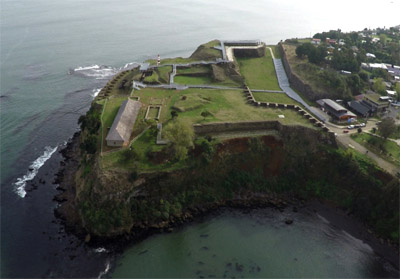 The Fuerte de Niebla, thanks to the good drone folks at XCam.cl. The Fuerte de Niebla, thanks to the good drone folks at XCam.cl. |
 |
The Spanish were disappointed in their hopes for convenient piles of gold, but decided to make Chile part of the Spanish Empire anyway. Valdivia was made the colony's governor, and in 1544 a river in Chile's south was named in his honor. He sailed down this river in a majestic fashion in 1553 and founded a city in his name, which was the southernmost point of the Spanish Empire at the time. Being Spanish, he of course didn't just name the city Valdivia, but Santa María la Blanca de Valdivia.
Through the second half of the 16th century, Valdivia became a major port of the Spanish Empire, coining gold and developing a major shipbuilding industry.
|
|
The Mapuche, the dominant tribe of locals, did not take kindly to being conquisted, and several major insurrections shrunk the Empire's borders: Valdivia was killed in the first such uprising, in 1553. The Mapuche allied with the equally indignant Huilliche in 1598, and launched a massive revolt that resulted in the Destruction of the Seven Cities: All Spanish cities south of the Bio-Bío River (which is much more entertaining in Spanish: Rio Bio-Bío) were laid waste, with over 3,000 Spaniards killed and some 500 Spanish women captured. Valdivia was one of these unfortunate cities.
|
Attempts were immediately made to reclaim Valdivia by the Spanish, but the surrounding area was extremely hostile, and it was impossible for the Spaniards to stay. The English and Dutch, meanwhile, were forever waiting in the wings for Spain to step on its own collective weenie in faraway lands, and take advantage. The Mapuche must have had warm and fuzzy feelings for the Dutch, for they allowed Dutch corsair (pirate) Sebastian de Cordes to occupy what was left of Valdivia for several months in 1600. De Cordes reported back to Holland that Valdivia and its gold mines were ripe for the picking, and the Dutch responded with lightning-quick efficiency by dispatching a Dutch East India Company expedition to the region...four decades later.
In the meantime, the Spanish were still trying to re-establish themselves at Valdivia. A force under Captain Francisco Hernández Ortiz (1555-1613) built some sort of fortification there in March of 1602, which was unsuccessfully attacked by the locals in September of that year. The thereafter-besieged fort was unable to keep itself supplied, and was abandoned in February of 1604.
|
 |
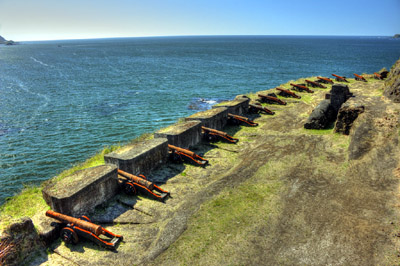 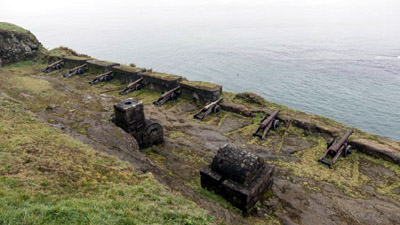 Apparently everyone who visits the Fuerte with a digital camera is required by law to take the picture at the top above, but this one is particularly nice with the red highlights on the guns...and below, another angle reveals...a hot shot furnace! Apparently everyone who visits the Fuerte with a digital camera is required by law to take the picture at the top above, but this one is particularly nice with the red highlights on the guns...and below, another angle reveals...a hot shot furnace! |
|
When the Dutch finally got around to showing up and occupying the ruins of Valdivia in 1643, grandly renaming the city Brouwershaven after the dude who was leading the expedition, they found not gold mines but hostile natives, and departed just a few months later. When made aware of this Dutch foolishness, Spanish Viceroy of Peru Pedro Álvarez de Toledo y Leiva (1585-1564) smacked his fist into his palm and bellowed, Eso es suficiente!! He determined that Valdivia would be reclaimed, once and for all, for the Spanish Crown. And thank goodness for that, because we can finally start talking about starforts.
|
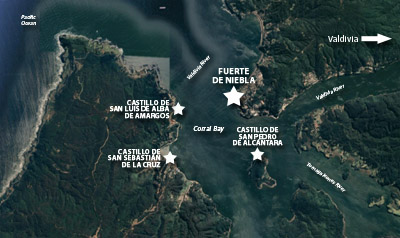 Four of the ten Spanish fortifications of Corral Bay remain in more or less visible condition. Please click it so you can see it! Four of the ten Spanish fortifications of Corral Bay remain in more or less visible condition. Please click it so you can see it! |
 |
The Spanish military presence in Chile was already the largest such body in South America, and a constant drain on the Viceroyalty of Peru...so the Viceroy resolved that he would pay for this venture out of his own pocket. Seventeen ships crammed with supplies, building materials and steely-eyed Spanish troops descended on Valdivia in 1645, and the seaborne approaches to the city, via Corral Bay, were fortified to within an inch of their lives over the next two decades.
Ten individual fortifications dotted Corral Bay, which was an impressive defense indeed against seaborne enemies: Another seven fortifications protected Valdivia's landward approaches. |
|
Spain's massive investment in defending Corral Bay made it the "Gibraltar of the Pacific." The basic plan was for four major forts, whose fire would crisscross in the bay: The rest of the fortifications were batteries and lookout posts. Of the anchor forts, that on Mancera Island, in the middle of the bay, was to be the linchpin.
Upon this island was the Castillo de San Pedro de Alcántara, begun in 1645, which was the first of these forts to be built. Twas armed with fifteen guns and two "turrets," which were probably round, castleoid crenellated towers. It was surrounded by a moat, and inside the Spanish managed to situate a church and two convents. Leave it to the Spanish to not only give their forts names that were so lengthy and religiously convoluted that nobody would actually refer to them with their full names...but also to see to the many spiritual needs of those forts' garrisons.
|
The Castillo de San Luis de Alba de Amargos was built across from the mouth of the Valdivia River, with eleven guns. It was also surrounded by a moat, and accessed by a drawbridge. It was built from 1655 to 1661, after which it mounted a breathtaking six guns...but when it was rebuilt in 1679, it doubled its firepower...and here you were, thinking six guns was excessive.
Work on the Castillo de San Sebastián de la Cruz was also begun in 1645, with further improvements made in 1678....perhaps that was when the Castillo got what appears to be an Olympic-sized swimming pool!
Once again, shown here are only the fortifications that are still visible today: Others with such entertaining names as Fuerte Aguada del Inglés, Batería y Reducto de Chorocamayo and Batería del Piojo also crowded the shores of Corall Bay in a defensively menacing fashion, but have since sadly passed into the depths. Or whatever the landward equivalent of passing into the depths is.
The Fuerte de Niebla appears to have been the finishing touch on Valdivia's defenses: Built from 1667 to 1672, the hill along its western side was reduced in 1715, to make room for the 18-gun battery that is this fort's most photogenic feature today. Niebla's full ridicu-name is Castillo de la Pura y Limpia Concepción de Monfort de Lemus, "Castle of the Pure and Clean Conception of Monfort de Lemus." This was in honor of the Viceroy of Peru, the 10th Earl of Lemus, whose conception must have been a particularly sterile event.
Incongruously, we must now bring the Irish into this story, because the Spanish government brought the Irish into Chile in the 18th and early 19th centuries. Chafed by the Protestant-run government of England, Catholic Irishpersons were enticed to settle in Chile, which was of course run by those most Catholic Spaniards. One of these persons was John "Juan" Garland, a military engineer who was named Gobernador de la Plaza Fuerte de Valdivia (Governor of the Stronghold of Valdivia) in 1768. Juan oversaw a complete overhaul of all of the Stronghold of Valdivia's defenses.
|
 |
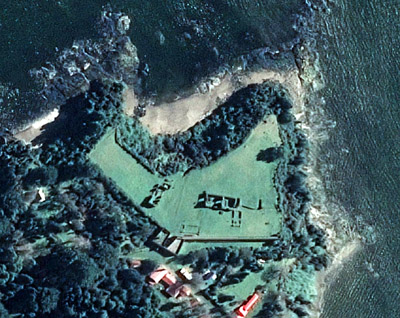 Castillo de San Pedro de Alcantara Castillo de San Pedro de Alcantara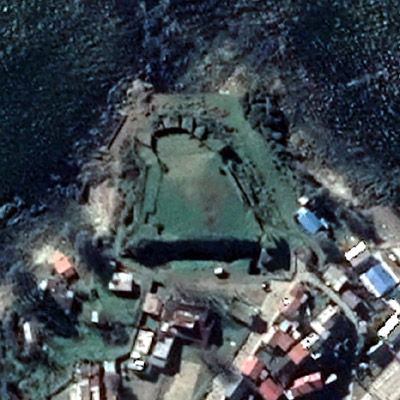 Castillo de San Luís de Alba de Amargos Castillo de San Luís de Alba de Amargos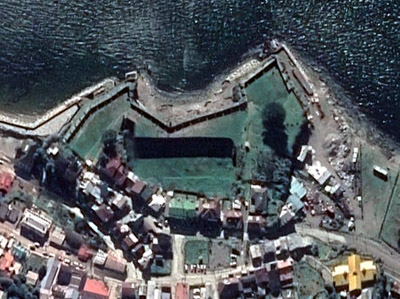 Castillo de San Sebastián de la Cruz Castillo de San Sebastián de la Cruz |
|
When I learned of Juan's participation in the modernization of these fortifications, it solved a perplexing issue. Whilst studying the many pictures of the Fuerte de Niebla's western battery that are available on the Internet, I noted that there are two small, stone and/or/brick structures directly behind the guns...one of which is clearly a hot shot furnace. This discovery excited me a great deal more than it would any normal person, in that I also run a site called HotShotFurnace.com, and whatever part of me is not already dedicated to finding starforts is dedicated to finding hot shot furnaces...which are generally a lot harder to come across than are starforts! What perplexed me was that, the masonry hot shot furnace didn't exist when the Fuerte had originally been built at the end of the 17th century! Enter Juan and his late 18th-century starfort knowledge, and the pieces all fell into place. The only reference I could find to that furnace on a Spanish Wikipedia page referred to it as a "furnace for the melting of bullets." Nobody was "melting bullets" next to a row of eighteen cannon, but perhaps the faulty description was a translation issue.
|
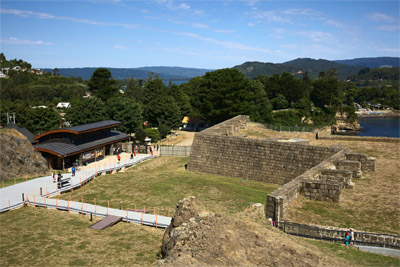 The fuerte's museum, which is located at its southeasternest extent. A snazzy walkway through the fort keeps visitors' footwear clean and unstarforted. The fuerte's museum, which is located at its southeasternest extent. A snazzy walkway through the fort keeps visitors' footwear clean and unstarforted. |
 |
While Valdivia's defenses were being constructed, folks lived on Mancara Island, which was easier to defend from all comers...but by the end of the 18th century they had moved to Valdivia's present location. And just as everything was starting to look rosy for the Spanish in Chile, whom should step onto the world stage but Napoleon (1769-1821).
In addition to all the other European apple carts he upset, Napoleon would replace Spain's King Charles IV (1748-1819) with his own brother, Joseph Bonaparte (1768-1844). The already frail connection betwixt Spain and her far-flung colonies was further stressed, and those colonies started thinking about independence. |
|
Well. Naturally there had been plenty of people in those colonies thinking about independence ever since they had been colonies, but there were also many royalists who were doing just fine with the status quo, thank you very much. Spain's royal governor of Chile was Luis Muñoz de Guzmán (1735-1808), who was respected and effective...but he died in 1808, and Spain was plunged into war with France before the crown could appoint a new governor. The most senior Spanish military commander in Chile at the time was Brigadier Francisco Antonio García Carrasco (1742-1813), who took over the governorship, despite the fact that he was an authoritarian, flagrantly corrupt weenie, which did not benefit Spain's case for remaining in charge of Chile.
|
The Chilean War of Independence (1810-1821) ensued. Valdivia remained a Spanish stronghold through most of the war, but its days were numbered when Lord Cochrane (1775-1860), a brilliant British naval commander who had been discharged from the Royal Navy, was put in charge of the Chilean Navy.
On February 3, 1820, Cochrane & co. cracked the nut that was the system of Spanish fortifications of Corall Bay with an amphibious landing. In the dark of night, they landed and took Fort Ingles. They then managed to get amongst the Spaniards who were fleeing to the next fort up the line, Fort San Carlos, and nabbed that fort as well.
|
 |
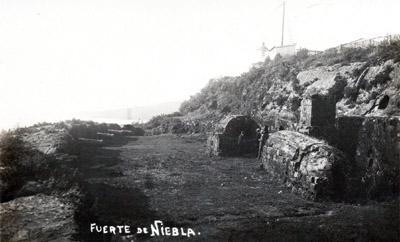 Fort Niebla's western battery in 1922, including some gentlemen in period headgear wondering why there would need to be an oven "for melting bullets" behind an artillery battery. Fort Niebla's western battery in 1922, including some gentlemen in period headgear wondering why there would need to be an oven "for melting bullets" behind an artillery battery. |
|
The Chilean landing force managed to capture all of the Spanish forts on the western side of the bay before Cochrane called it a night and settled in for what he figured would be a lengthy process of defeating the forts on the eastern bank of the bay, including el Fuerte de Niebla...but the next morning, those in charge of the fuerte of our present interest decided to flee instead.
Would the Fuerte de Niebla and the Castillo de San Pedro de Alcántara been able to withstand the rebel onslaught? Probably, but they didn't know by what black magic the Chileans had snapped up all those other impregnable fortresses, and may have envisioned some sort of anti-Catholic death ray being unleashed upon them at any moment. Whatever, the town of Valdivia surrendered to the Chileans soon thereafter. The Spaniards retreated in good order, but their last stronghold in mainland Chile had been taken...and all those impressive and expensive fortifications around Valdivia had been absolutely no help whatsoever.
The Fuerte de Niebla was declared an Historic Monument in 1950, but it wasn't until the 1990's that significant restoration work, and scientific excavations, got underway. Today the fort looks to be in excellent shape, and is free to visit year 'round...though visitors are strictly forbidden to scratch, climb walls and archaeological remains or enter restricted areas, which pretty much takes the fun out of the whole thing, now doesn't it.
|
|
|
|
|
|
 |




